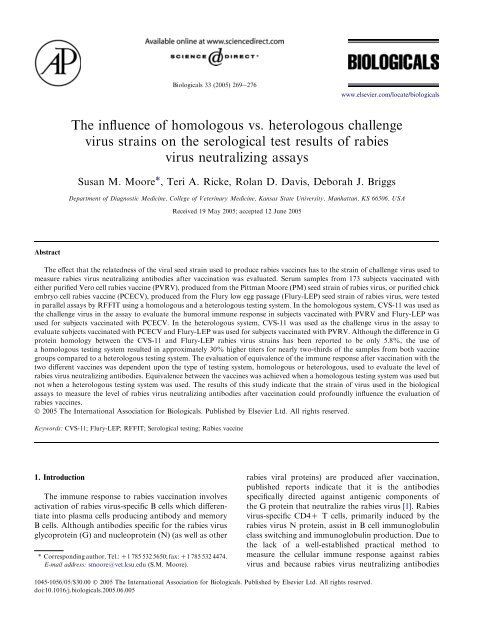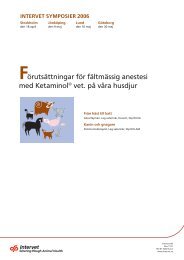KVÄLLSSYMPOSIUM 2008 Vaccinering av hund och katt
KVÄLLSSYMPOSIUM 2008 Vaccinering av hund och katt
KVÄLLSSYMPOSIUM 2008 Vaccinering av hund och katt
You also want an ePaper? Increase the reach of your titles
YUMPU automatically turns print PDFs into web optimized ePapers that Google loves.
Abstract<br />
The influence of homologous vs. heterologous challenge<br />
virus strains on the serological test results of rabies<br />
virus neutralizing assays<br />
Susan M. Moore*, Teri A. Ricke, Rolan D. D<strong>av</strong>is, Deborah J. Briggs<br />
Department of Diagnostic Medicine, College of Veterinary Medicine, Kansas State University, Manhattan, KS 66506, USA<br />
Received 19 May 2005; accepted 12 June 2005<br />
The effect that the relatedness of the viral seed strain used to produce rabies vaccines has to the strain of challenge virus used to<br />
measure rabies virus neutralizing antibodies after vaccination was evaluated. Serum samples from 173 subjects vaccinated with<br />
either purified Vero cell rabies vaccine (PVRV), produced from the Pittman Moore (PM) seed strain of rabies virus, or purified chick<br />
embryo cell rabies vaccine (PCECV), produced from the Flury low egg passage (Flury-LEP) seed strain of rabies virus, were tested<br />
in parallel assays by RFFIT using a homologous and a heterologous testing system. In the homologous system, CVS-11 was used as<br />
the challenge virus in the assay to evaluate the humoral immune response in subjects vaccinated with PVRV and Flury-LEP was<br />
used for subjects vaccinated with PCECV. In the heterologous system, CVS-11 was used as the challenge virus in the assay to<br />
evaluate subjects vaccinated with PCECV and Flury-LEP was used for subjects vaccinated with PVRV. Although the difference in G<br />
protein homology between the CVS-11 and Flury-LEP rabies virus strains has been reported to be only 5.8%, the use of<br />
a homologous testing system resulted in approximately 30% higher titers for nearly two-thirds of the samples from both vaccine<br />
groups compared to a heterologous testing system. The evaluation of equivalence of the immune response after vaccination with the<br />
two different vaccines was dependent upon the type of testing system, homologous or heterologous, used to evaluate the level of<br />
rabies virus neutralizing antibodies. Equivalence between the vaccines was achieved when a homologous testing system was used but<br />
not when a heterologous testing system was used. The results of this study indicate that the strain of virus used in the biological<br />
assays to measure the level of rabies virus neutralizing antibodies after vaccination could profoundly influence the evaluation of<br />
rabies vaccines.<br />
Ó 2005 The International Association for Biologicals. Published by Elsevier Ltd. All rights reserved.<br />
Keywords: CVS-11; Flury-LEP; RFFIT; Serological testing; Rabies vaccine<br />
1. Introduction<br />
Biologicals 33 (2005) 269e276<br />
The immune response to rabies vaccination involves<br />
activation of rabies virus-specific B cells which differentiate<br />
into plasma cells producing antibody and memory<br />
B cells. Although antibodies specific for the rabies virus<br />
glycoprotein (G) and nucleoprotein (N) (as well as other<br />
* Corresponding author. Tel.: C1 785 532 5650; fax: C1 785 532 4474.<br />
E-mail address: smoore@vet.ksu.edu (S.M. Moore).<br />
rabies viral proteins) are produced after vaccination,<br />
published reports indicate that it is the antibodies<br />
specifically directed against antigenic components of<br />
the G protein that neutralize the rabies virus [1]. Rabies<br />
virus-specific CD4C T cells, primarily induced by the<br />
rabies virus N protein, assist in B cell immunoglobulin<br />
class switching and immunoglobulin production. Due to<br />
the lack of a well-established practical method to<br />
measure the cellular immune response against rabies<br />
virus and because rabies virus neutralizing antibodies<br />
1045-1056/05/$30.00 Ó 2005 The International Association for Biologicals. Published by Elsevier Ltd. All rights reserved.<br />
doi:10.1016/j.biologicals.2005.06.005<br />
www.elsevier.com/locate/biologicals





